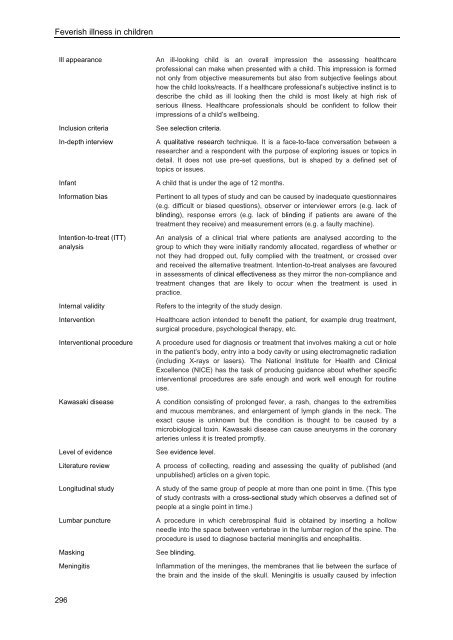A5V4d
A5V4d
A5V4d
You also want an ePaper? Increase the reach of your titles
YUMPU automatically turns print PDFs into web optimized ePapers that Google loves.
Feverish illness in children<br />
Ill appearance An ill-looking child is an overall impression the assessing healthcare<br />
professional can make when presented with a child. This impression is formed<br />
not only from objective measurements but also from subjective feelings about<br />
how the child looks/reacts. If a healthcare professional’s subjective instinct is to<br />
describe the child as ill looking then the child is most likely at high risk of<br />
serious illness. Healthcare professionals should be confident to follow their<br />
impressions of a child’s wellbeing.<br />
Inclusion criteria See selection criteria.<br />
In-depth interview A qualitative research technique. It is a face-to-face conversation between a<br />
researcher and a respondent with the purpose of exploring issues or topics in<br />
detail. It does not use pre-set questions, but is shaped by a defined set of<br />
topics or issues.<br />
Infant A child that is under the age of 12 months.<br />
Information bias Pertinent to all types of study and can be caused by inadequate questionnaires<br />
(e.g. difficult or biased questions), observer or interviewer errors (e.g. lack of<br />
blinding), response errors (e.g. lack of blinding if patients are aware of the<br />
treatment they receive) and measurement errors (e.g. a faulty machine).<br />
Intention-to-treat (ITT)<br />
analysis<br />
296<br />
An analysis of a clinical trial where patients are analysed according to the<br />
group to which they were initially randomly allocated, regardless of whether or<br />
not they had dropped out, fully complied with the treatment, or crossed over<br />
and received the alternative treatment. Intention-to-treat analyses are favoured<br />
in assessments of clinical effectiveness as they mirror the non-compliance and<br />
treatment changes that are likely to occur when the treatment is used in<br />
practice.<br />
Internal validity Refers to the integrity of the study design.<br />
Intervention Healthcare action intended to benefit the patient, for example drug treatment,<br />
surgical procedure, psychological therapy, etc.<br />
Interventional procedure A procedure used for diagnosis or treatment that involves making a cut or hole<br />
in the patient’s body, entry into a body cavity or using electromagnetic radiation<br />
(including X-rays or lasers). The National Institute for Health and Clinical<br />
Excellence (NICE) has the task of producing guidance about whether specific<br />
interventional procedures are safe enough and work well enough for routine<br />
use.<br />
Kawasaki disease A condition consisting of prolonged fever, a rash, changes to the extremities<br />
and mucous membranes, and enlargement of lymph glands in the neck. The<br />
exact cause is unknown but the condition is thought to be caused by a<br />
microbiological toxin. Kawasaki disease can cause aneurysms in the coronary<br />
arteries unless it is treated promptly.<br />
Level of evidence See evidence level.<br />
Literature review A process of collecting, reading and assessing the quality of published (and<br />
unpublished) articles on a given topic.<br />
Longitudinal study A study of the same group of people at more than one point in time. (This type<br />
of study contrasts with a cross-sectional study which observes a defined set of<br />
people at a single point in time.)<br />
Lumbar puncture A procedure in which cerebrospinal fluid is obtained by inserting a hollow<br />
needle into the space between vertebrae in the lumbar region of the spine. The<br />
procedure is used to diagnose bacterial meningitis and encephalitis.<br />
Masking See blinding.<br />
Meningitis Inflammation of the meninges, the membranes that lie between the surface of<br />
the brain and the inside of the skull. Meningitis is usually caused by infection


